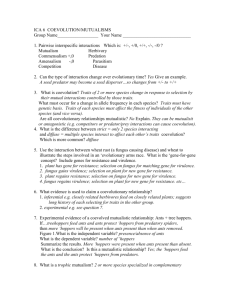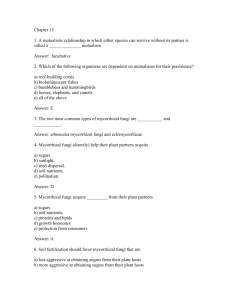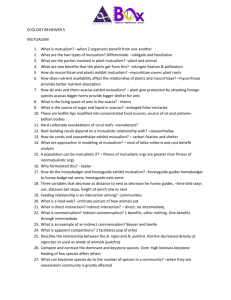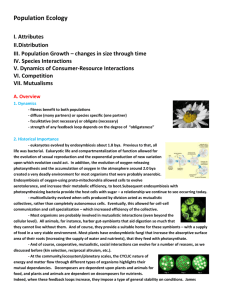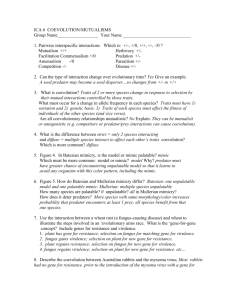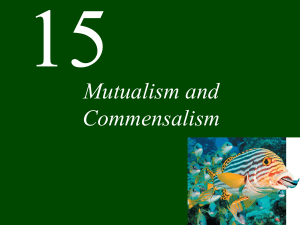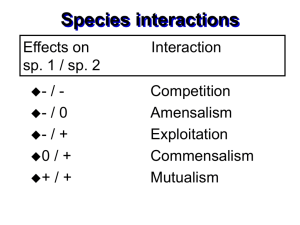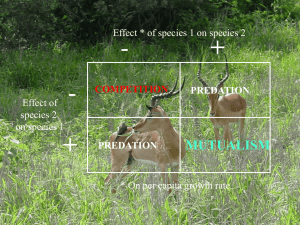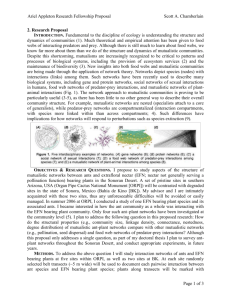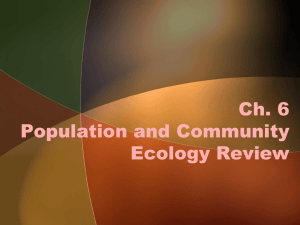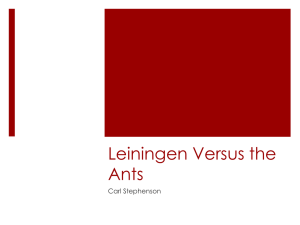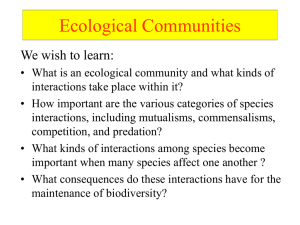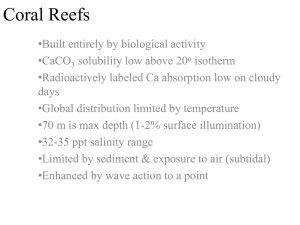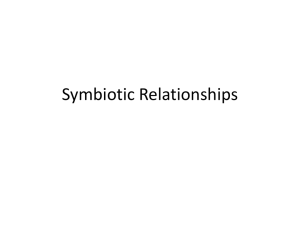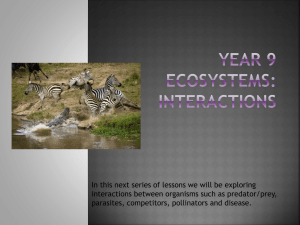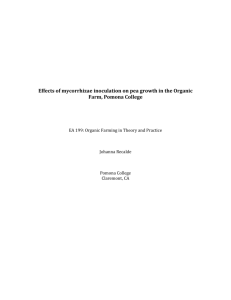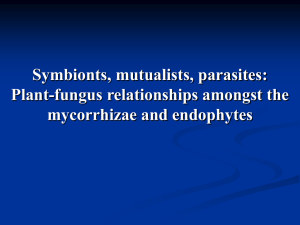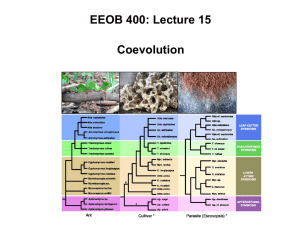Notes
advertisement
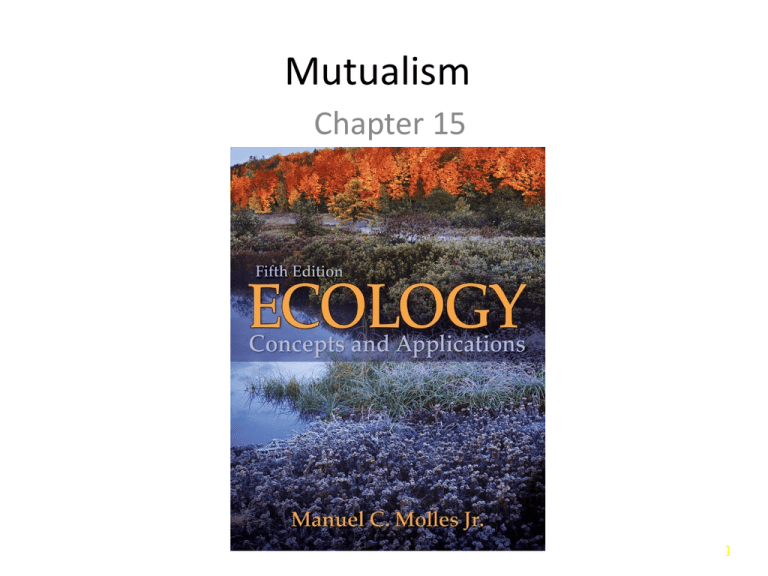
Mutualism Chapter 15 1 Introduction • Mutualism: Interactions between individuals of different species that benefit both partners. – Facultative Mutualism occurs when a species can live without its mutualistic partner. – Obligate Mutualism occurs when a species is dependent on a mutualistic relationship. • Margulis and Fester amassed evidence eukaryotes originated as mutualistic associations. 2 Plant Performance and Mycorrhizal Fungi • Two most common types of mycorrhizae: 1) Arbuscular mycorrhizal fungi (AMF) Produces arbuscules - site of exchange between plants and fungi, hyphae - fungal filaments, and vesicles - energy storage organs. 3 Plant Performance and Mycorrhizal Fungi • Two most common types of mycorrhizae: 2) Ectomycorrhizae (ECM) • Forms mantle around roots - important in increasing plant access to phosphorus and other immobile nutrients. 4 Mycorrhizae and Plant Water Balance • Allen and Allen studied water relations of grass Agropyron smithii. – Plants with mycorrhizae maintained higher leaf water potentials. 5 Mycorrhizae and Plant Water Balance • Hardie suggested mycorrhizal fungi improve water relations by providing more extensive contact with moisture in rooting zone and providing extra area for water absorption. 6 Nutrient Availability and Mutualistic Balance Sheet • Johnson investigated whether fertilization can select for less mutualistic mycorrhizal fungi. – Fungal partner received an equal or greater quantity of photosynthetic product in trade for low quantity of nutrients. • In nutrient poor environments, many plants invest disproportionately in roots. 7 Nutrient Availability • Results suggested mycorrhizal fungi from unfertilized soils supplied plants with more nutrients. – Plants able to invest more energy in above-ground photosynthetic material… principle of ? 8 The Private Life of Plants - ?, Bull’s horn acacia clip 9 Ants and Bull’s horn Acacia • Herbivores attempting to forage on accacia plants occupied by accacia ants are met by a large number of fast, agile, highly-aggressive defenders. • Ant Benefits: – Thorns provide living space. – Folliar nectaries provide sugar. – Beltian bodies are a source of oils and protein. 10 Ants and Bull’s horn Acacia 11 Experimental Evidence For Mutualism • Janzen demonstrated ants significantly improve plant performance. – Acacias without ants had more herbivorous insects. – Suckers growing from accacia stumps occupied by ants lengthened at seven times rate of suckers without ants. • Suckers with ants survived at twice the rate of suckers without ants. 12 Planet Earth - Shallow Seas, corals clip 13 Coral Mutualisms • Zooxanthallae and Corals – Zooxzanthallae live within coral tissues. • Receive nutrient from coral. In return, coral receives organic compounds synthesized by zooxanthallae during photosynthesis. – Corals induce release of organic compounds with “signal compounds” that alter permeability of zooxanthallae cell membrane. 14 Coral Mutualisms • Corals also control rate of zooxanthallae population growth and density by influencing organic matter secretion. • Main zooxanthallae benefit appears to be access to higher nutrient levels, especially N and P. – Uptakes ammonium excreted by coral. 15 Coral Protection Mutualism • Glynn found 13 coral species protected by crustacean mutualists. – Crustacean mutualists substantially improved chances coral will avoid attack by sea stars. 16 Coral Protection Mutualism • Also found crab activity promotes coral health and integrity. – Pocillopora coral increases production of fat bodies in the presence of crabs. • Digestive tract of crabs inhabiting corals contained large quantities of lipids. 17 Evolution of Mutualism • Theory predicts mutualism will evolve where the benefits of mutualism exceed the costs. – Keeler developed models to represent relative costs and benefits of several types of mutualistic interactions. • Successful mutualists – Give and receive benefits. • Unsuccessful mutualists – Give, but do not receive benefit. 18 Evolution of Mutualism • Non-mutualists – Neither give nor receive benefit. • For a population to be mutualistic, fitness of successful mutualists must be greater than unsuccessful or non-mutualists. – If not, natural selection will eventually eliminate the interaction. 19 Facultative Ant-Plant Mutualisms • Keeler proposed for a facultative ant-plant mutualism to evolve and persist… • proportion of plant’s energy budget ants save from destruction by herbivores… • must exceed proportion of the plant’s energy budget invested in extrafloral nectaries and nectar. 20 Facultative Ant-Plant Mutualisms • Conditions that may produce higher benefits than costs: – Low proportion of plant’s energy budget invested in extrafloral nectaries. – High probability of attracting ants. – Low effectiveness of alternate defenses. – Highly effective ant defense. 21 Facultative Ant-Plant Mutualisms p [H ( 1 – D ) A ] > IA Probability of attracting mutualist Rate of herbivory Effectiveness of plant defenses Effectiveness of ant defenses Plant’s energy budget devoted to “bribes” 22 23
